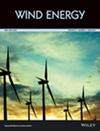利用相干聚合为海上风电场工程模型建立合成湍流模型
IF 3.3
3区 工程技术
Q3 ENERGY & FUELS
引用次数: 0
摘要
众所周知,湍流风场是海上风力涡轮机结构负载和功率波动的主要驱动因素。在单涡轮机规模上,有基于多年测量校准的风频谱和相干函数的成熟设计标准,这些标准用于生成多个 10 分钟风场实景(称为合成湍流箱),这些实景被用作涡轮机规模的空气-水-伺服弹性代码的输入。然而,这些方法并不能直接应用于风电场规模。在分析大型海上风电场的动态时,测量结果表明,大型低频湍流涡旋对功率波动非常重要,因此对风电场控制和并网也非常重要。此外,农场规模的风场需要作为农场规模的航空-伺服-弹性代码的输入,以建立影响结构载荷的尾流动力学模型。这些新问题促使我们对原有的涡轮机级风场表示方法进行升级:(1)频谱模型需要以农场级测量为基础;(2)必须取消融合了时间和沿风一致性的冻结湍流假设;(3)当域变得过大时,需要进行简化以减少自由度数量。本文提出了适用于大型海上风电场气-水-伺服弹性建模的全风电场聚集相关合成湍流生成模型和算法--将风场集合为空间平均量。从 Sørensen 等人在 2000 年代初为并网目的所做的工作开始,引入了结构载荷建模方法(通过尾流蜿蜒和高分辨率风场重建)。然后介绍了涉及数学微妙之处的实施和效率问题。最后,还进行了数值实验,以(1)对照最先进的基于点的合成湍流生成代码(而非聚合湍流生成代码)验证方法和实施情况,(2)说明聚合湍流对大型海上风电场建模的益处。本文章由计算机程序翻译,如有差异,请以英文原文为准。
Synthetic turbulence modelling for offshore wind farm engineering models using coherence aggregation
Turbulent wind fields are known to be a major driver for structural loads and power fluctuations on offshore wind turbines. At the single‐turbine scale, there exist well‐established design standards based on wind spectra and coherence functions calibrated from years of measurements, which are used to generate multiple 10‐min wind field realisations known as synthetic turbulence boxes, themselves used as input to turbine‐scale aero‐hydro‐servo elastic codes. These methods are however not directly applicable at farm scale. When analysing the dynamics of large offshore wind farms, measurements reveal the importance of large, low‐frequency turbulent vortices for power fluctuations and hence for wind farm control and grid integration. Also, farm‐scale wind fields are needed as input to farm‐scale aero‐servo‐elastic codes for the modelling of wake dynamics, affecting structural loads. These new concerns motivate an upgrade in the original turbine‐scale wind field representation: (1) spectral models need to be based on farm‐scale measurements, (2) the frozen‐turbulence assumption merging temporal and along‐wind coherence must be lifted, (3) simplifications are needed to reduce the number of degrees of freedom as the domain becomes excessively large. This paper suggests models and algorithms for aggregated farm‐wide corrrelated synthetic turbulence generation—lumping the wind field into space‐averaged quantities—adapted to the aero‐hydro‐servo elastic modelling of large offshore wind farms. Starting from the work of Sørensen et al. in the early 2000s for grid integration purposes, methods for structural load modelling (through wake meandering and high‐resolution wind field reconstruction) are introduced. Implementation and efficiency matters involving mathematical subtleties are then presented. Finally, numerical experiments are carried out to (1) verify the approach and implementation against a state‐of‐the‐art point‐based—as opposite to aggregated—synthetic turbulence generation code and (2) illustrate the benefit of turbulence aggregation for the modelling of large offshore wind farms.
求助全文
通过发布文献求助,成功后即可免费获取论文全文。
去求助
来源期刊

Wind Energy
工程技术-工程:机械
CiteScore
9.60
自引率
7.30%
发文量
0
审稿时长
6 months
期刊介绍:
Wind Energy offers a major forum for the reporting of advances in this rapidly developing technology with the goal of realising the world-wide potential to harness clean energy from land-based and offshore wind. The journal aims to reach all those with an interest in this field from academic research, industrial development through to applications, including individual wind turbines and components, wind farms and integration of wind power plants. Contributions across the spectrum of scientific and engineering disciplines concerned with the advancement of wind power capture, conversion, integration and utilisation technologies are essential features of the journal.
 求助内容:
求助内容: 应助结果提醒方式:
应助结果提醒方式:


